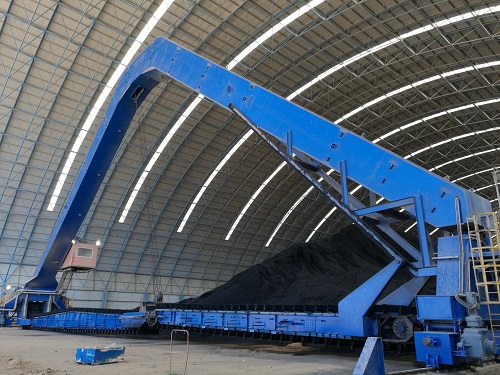Advantages of scraper reclaimer and how to choose a suitable scraper reclaimer
scraper reclaimer
Scraper reclaimer is an advanced material conveying device, which is mainly used for material conveying and stacking in industrial production and logistics industry. The main function of the scraper reclaimer is to pull the material barrel to realize the automatic conveying of materials. With the continuous development of technology, the scraper reclaimer has become one of the important equipment in the logistics industry, and is widely used in construction, chemical, mining, food, beverage and other industries.

Advantages of scraper reclaimer:
1. Automatic control: The scraper reclaimer realizes the automatic transportation of materials through the automatic control system, without manual intervention, which can greatly improve the production efficiency.
2. Large capacity: The scraper reclaimer has the characteristics of large capacity, which can process a large amount of materials quickly and efficiently.
3. Flexible adaptability: the scraper reclaimer can be self-adapted according to the actual situation of the production site, and is suitable for various material conveying needs.
4. Simple operation: The operation of the scraper reclaimer is very simple, you only need to follow the instructions to complete each task.
How to choose a suitable scraper reclaimer:
1. The characteristics of the material should be considered: the scraper reclaimer can be adapted to different types of materials, but different materials may require different models and specifications of the scraper reclaimer.
2. To consider the container/barrel of the material: to choose a suitable scraper reclaimer, you need to consider the actual material container, such as weight, capacity and shape, etc.
3. The convenience of on-site operation should be considered: the operation convenience of the scraper reclaimer also needs to be considered, such as the height of the discharge port, the operation area and the operation method.
4. Quality and reliability: It is very important to choose a reliable quality scraper reclaimer, which can ensure the stability and safety of the equipment and reduce the frequency of maintenance and replacement.
Generally speaking, the scraper reclaimer is one of the most important equipment in the logistics industry, which can greatly improve production efficiency and material transportation safety. When choosing a scraper reclaimer, a variety of factors need to be considered, such as the characteristics of the material, the material container, the convenience of on-site operation, and the reliability of quality. By choosing a scraper reclaimer reasonably, you can quickly improve production efficiency and reduce costs, and better achieve the production and management goals of the enterprise.
 O'zbek
O'zbek slovenský
slovenský Azərbaycan
Azərbaycan Қазақ
Қазақ Latine
Latine ລາວ
ລາວ български
български नेपाली
नेपाली فارسی
فارسی Javanese
Javanese Українська
Українська Lietuvos
Lietuvos Română
Română Slovenski
Slovenski پښتو
پښتو Punjabi
Punjabi Bosanski
Bosanski Malti
Malti Galego
Galego Afrikaans
Afrikaans Esperanto
Esperanto 简体中文
简体中文 Српски
Српски मराठी
मराठी Ελληνικά
Ελληνικά čeština
čeština Polski
Polski ไทย
ไทย Nederlands
Nederlands Italiano
Italiano Tiếng Việt
Tiếng Việt Deutsch
Deutsch français
français русский
русский Português
Português Español
Español 한국어
한국어 Svenska
Svenska Malay
Malay اردو
اردو norsk
norsk Indonesia
Indonesia عربى
عربى Gaeilge
Gaeilge Türk
Türk Pilipino
Pilipino हिन्दी
हिन्दी Dansk
Dansk বাংলা
বাংলা English
English


The Expanding Role of Long Distance Conveyors in Modern Industrial Applications
In the modern era of industrial automation and large-scale material handling, the Long Distance Conveyor has emerged as a crucial technology for improving efficiency and reducing transportation costs. Designed to move bulk materials over extended distances, these conveyors are now widely applied in mining, cement production, power generation, port logistics, and other heavy industries that require reliable, continuous transport systems.
Read MoreThe Expanding Applications of Rotary Drum Mixers in Modern Industries
In today’s fast-paced industrial environment, the Rotary Drum Mixer has become a vital piece of equipment across various sectors due to its reliability, efficiency, and ability to handle diverse materials. Known for its robust design and uniform mixing performance, this machine plays a key role in industries such as pharmaceuticals, chemicals, food processing, construction, and agriculture.
Read MoreJuli Engineering: A Trusted Supplier of Durable Coal Screw Feeders for Reliable Material Handling
In the fast-evolving industrial sector, efficiency, durability, and reliability are essential in material handling systems. Juli Engineering, a leading Durable Coal Screw Feeder supplier, continues to set industry standards with its high-quality products designed for continuous and precise coal feeding applications. With a reputation for engineering excellence and long-term performance, Juli Engineering provides advanced screw feeder solutions that meet the demanding needs of power plants, mining operations, and industrial production lines.
Read More